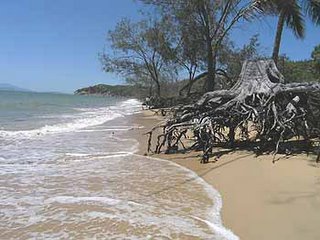Tsunami Mitigation

Reading through many of the websites on tsunami mitigation one sees that the focus has been largely on early warning strategies and coordinating movement of people away from the oncoming tsunami. Little attention has been given to developing positive mitigation procedures long before the event.
Looking at past tsunami disasters that hit countries like Chile, Hawaii and Japan, one gathers that there have been valuable lessons that might need to be re-focused on in order to develop strategies for coping. However, strategies for coping would often require large sums of money which world bodies and poor countries might not necessarily see as practical in the long run eg one could posit the re-siting of townships on higher ground, the building of massive concrete bunds to hold back the flow and so forth... Such measures would be far from practical in the parts of Aceh or the Indian Ocean islands hit by the recent tsunami since their economies would not be able to bear the brunt of the cost; also, in a place like Phuket, which arguably would be able to spend from the wealth generated by tourism, the measures might actually be counter-productive since they will destroy the scenic aspects or tourist potential of the locality.
Nonetheless, there are practical measures which - added to the mitigation efforts in the style of say the Redwood Coast Tsunami Work Group could very well help lower the casualty rate of tsunami disasters. Actually, when I read about the Redwood Coast project I expected a kind of forestation project linked to tsunami mitigation - but it was more about planning, teamwork or coordinating people in the face of a tsunami crisis; all of which is, of course, tremendously important in lowering the eventual casualty rate.
There are, however, long-term measures which can ensure that the casualty rate is significantly lowered and the Chilean Tsunami of 1960 is a case in point. Among the many factors leading to a high casualty rate was the fact that unlike simple flooding, a tsunami moves in with great force - which often means that even expert swimmers can drown since they would be hit by debris and smashed against immoveable objects and pulled from whatever it was that they were clinging onto; notably, in the Chilean crisis, a significant number of people survived by simply climbing trees that were high enough above the water-level or going up to the rooftops of buildings that were still standing. Unfortunately, one got the impression - viewing some of the disaster pictures - that there were not enough trees and strong buildings around to prevent a casualty rate of tragic proportions.
Two recommendations that are not impractically expensive are:
1. The implementation of a long-term coastal forestry project that would ensure a tree buffer to lower the force of the onrushing waters from the sea; in addition, the roads in the town should be tree-lined in order to enable residents to be assured of anchor points if they are too late to be evacuated. For the tree buffer, strong, deeply-rooted trees like casuarinas would be excellent since they thrive in coastal tropic & semi-tropical locations; supplementary cover could be provided by the fast-growing dillenia indica or the hardy acacia longifolia as well as the acacia confusia.
The horticultural expertise and the saplings could be donated through the coordination services of the UN; countries like Australia and those in Latin America would be able to supply the necessary expertise and tree species for the implementation of the programme.
2. A relatively more expensive yet not too impracticable programme would be to ensure that in the rebuilding of the destroyed towns only architecturally survivable buildings of four stories and more (with flat rooftops) would be promoted; the architectural expertise that the UN has at its disposal would be of immense use in this initiative...
3. The prevention of the establishment of shanty towns in low coastal areas as a way of lowering the casualty rate since it was apparent that many lives were lost as a consequence of little or no protection afforded by the kinds of structures one associates with shanty towns.
These three recommendations are a small contribution to the global attempt to mitigate the consequences of any future tsunami. Noting that many of the townships that have suffered this recent disaster may not have the means for more sophisticated survival projects, the idea was to present fairly low-cost alternatives which - in the case of the planting of casuarinas - might help provide for a cheap source of strong timber if the coastal forest outgrows its usefulness.
